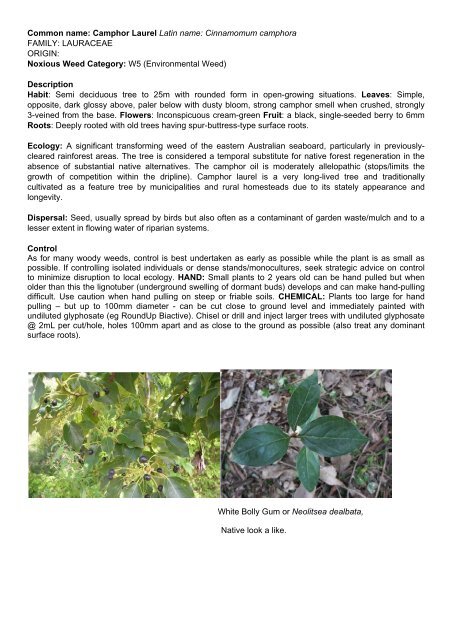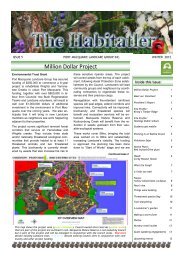Get the Latest information on fighting weeds - Port Macquarie ...
Get the Latest information on fighting weeds - Port Macquarie ...
Get the Latest information on fighting weeds - Port Macquarie ...
Create successful ePaper yourself
Turn your PDF publications into a flip-book with our unique Google optimized e-Paper software.
Comm<strong>on</strong> name: Camphor Laurel Latin name: Cinnamomum camphora<br />
FAMILY: LAURACEAE<br />
ORIGIN:<br />
Noxious Weed Category: W5 (Envir<strong>on</strong>mental Weed)<br />
Descripti<strong>on</strong><br />
Habit: Semi deciduous tree to 25m with rounded form in open-growing situati<strong>on</strong>s. Leaves: Simple,<br />
opposite, dark glossy above, paler below with dusty bloom, str<strong>on</strong>g camphor smell when crushed, str<strong>on</strong>gly<br />
3-veined from <str<strong>on</strong>g>the</str<strong>on</strong>g> base. Flowers: Inc<strong>on</strong>spicuous cream-green Fruit: a black, single-seeded berry to 6mm<br />
Roots: Deeply rooted with old trees having spur-buttress-type surface roots.<br />
Ecology: A significant transforming weed of <str<strong>on</strong>g>the</str<strong>on</strong>g> eastern Australian seaboard, particularly in previouslycleared<br />
rainforest areas. The tree is c<strong>on</strong>sidered a temporal substitute for native forest regenerati<strong>on</strong> in <str<strong>on</strong>g>the</str<strong>on</strong>g><br />
absence of substantial native alternatives. The camphor oil is moderately allelopathic (stops/limits <str<strong>on</strong>g>the</str<strong>on</strong>g><br />
growth of competiti<strong>on</strong> within <str<strong>on</strong>g>the</str<strong>on</strong>g> dripline). Camphor laurel is a very l<strong>on</strong>g-lived tree and traditi<strong>on</strong>ally<br />
cultivated as a feature tree by municipalities and rural homesteads due to its stately appearance and<br />
l<strong>on</strong>gevity.<br />
Dispersal: Seed, usually spread by birds but also often as a c<strong>on</strong>taminant of garden waste/mulch and to a<br />
lesser extent in flowing water of riparian systems.<br />
C<strong>on</strong>trol<br />
As for many woody <strong>weeds</strong>, c<strong>on</strong>trol is best undertaken as early as possible while <str<strong>on</strong>g>the</str<strong>on</strong>g> plant is as small as<br />
possible. If c<strong>on</strong>trolling isolated individuals or dense stands/m<strong>on</strong>ocultures, seek strategic advice <strong>on</strong> c<strong>on</strong>trol<br />
to minimize disrupti<strong>on</strong> to local ecology. HAND: Small plants to 2 years old can be hand pulled but when<br />
older than this <str<strong>on</strong>g>the</str<strong>on</strong>g> lignotuber (underground swelling of dormant buds) develops and can make hand-pulling<br />
difficult. Use cauti<strong>on</strong> when hand pulling <strong>on</strong> steep or friable soils. CHEMICAL: Plants too large for hand<br />
pulling – but up to 100mm diameter - can be cut close to ground level and immediately painted with<br />
undiluted glyphosate (eg RoundUp Biactive). Chisel or drill and inject larger trees with undiluted glyphosate<br />
@ 2mL per cut/hole, holes 100mm apart and as close to <str<strong>on</strong>g>the</str<strong>on</strong>g> ground as possible (also treat any dominant<br />
surface roots).<br />
White Bolly Gum or Neolitsea dealbata,<br />
Native look a like.



